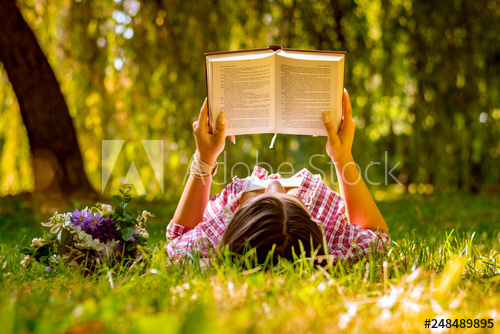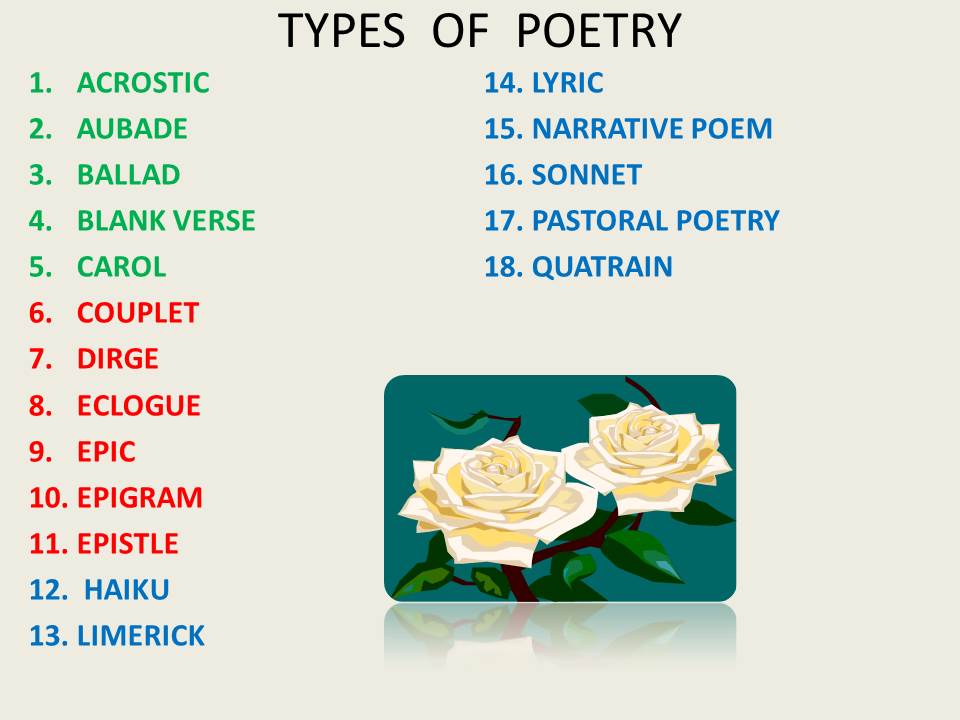
HI READERS! Welcome to the POETRY section. In my last blog , we studied about what is poetry ,its different traits and the necessity of reading poetry. Let us make a quick recall . Poetry is a kind of literature that employs the use of rhyme and meter along with the presence of devices like figures of speech, imagery, mood and tone . It is in verse form . It evokes or stirs our deep emotions and raise our levels of imagination.
NOW LET US STUDY ABOUT THE DIFFERENT TYPES OF POETRY. There is a need to study the various form and types of poetry owing to the differences based on the style of writing, the mood and tone of the poem , literary devices used in the poetry etc. The different types of poetry that we will study today are:

So let us begin .
1. The first type of Poetry is “ACROSTIC“: Acrostics are a fun poetic form. An Acrostic is a poem in which the first letters of each line spell out a word or a phrase. Have a look at the following example of acrostic by Edgar Allan Poe. Pay attention to the way the first letter of each line when combined forms a word ‘ELIZABETH’.
Edgar Allan Poe’s “An Acrostic”:
Elizabeth it is in vain you say
“Love not”-thou sayest it in so sweet a way:
In vain those words from thee or L.E.L.
Zantippe’s talents had enforced so well:
Ah! if that language from thy heart arise,
Breath it less gently forth-and veil thine eyes.
Endymion, recollect, when Luna tried
To cure his love-was cured of all beside-
His follie-pride-and passion-for he died.
Let us create an acrostic poem with the word SUNDAY.
S- Saintly Sun is brightly shining,
U- Up it goes in sky, sweet and smiling.
N- Never for a once it takes rest,
D- Day begins to dazzle at its best,
A- And when comes the hazy twilight,
Y- Yonder goes the sun to hide there right.
2. AUBADE : ‘Aubade’ is a term from French language. It is a song or poem in praise of the dawn (early morning). It has been described as a morning love song or a poem about lovers separating at dawn. Read the first stanza following poem THE SUNNE RISING by JOHN DONNE. It is a greeting poem to dawn where the sun is being called an old fool and intruder who is disturbing the speaker and his sleeping beloved. An Aubade is thus “a song or instrumental composition concerning, accompanying, or evoking daybreak”
” Busy old fool, unruly sun,
Why dost thou thus,
Through windows, and through curtains call on us?
Must to thy motions lovers’ seasons run?
Saucy pedantic wretch, go chide
Late school boys and sour prentices,
Go tell court huntsmen that the king will ride,
Call country ants to harvest offices,
Love, all alike, no season knows nor clime,
Nor hours, days, months, which are the rags of time.”
3. BALLAD : The word BALLAD has been derived from the French word ‘Ballade’ meaning ‘dance song’ . It is a narrative song which were passed down orally. It is a verse form set to music.It tells a story may be tragic or romantic or comic or heroic. Ballads are often 13 lines with an ABABBCBC form, consisting of couplets (two lines) of rhymed verse, each of 14 syllables. Another common form is ABAB or ABCB repeated, in alternating 8 and 6 syllable lines.Let us read the following example of a Ballad. LA BELLE DAME SANS MERCY poem by JOHN KEATS. the poem tells the story of bewildered knight who has been deceived by a beautiful lady .
“O what can ail thee, knight-at-arms,
Alone and palely loitering?
The sedge has withered from the lake,
And no birds sing.”
. . . . . . . . . . . . . . .
. . . . . . . . . . . . . . .
“I met a lady in the meads,
Full beautiful—a faery’s child,
Her hair was long, her foot was light,
And her eyes were wild.”
4. BLANK VERSE: Blank verse is a kind of poem which is unrhymed and is in Iambic pentametre form. It is also called ‘Heroic verse’. Iambic pentameter is a line of verse with five metrical feet . Sometimes different meters like spondees and dactyls have been used by poets to write in blank verse. It means that Blank verse has a consistent metre but no particular rhyme scheme . Some of the examples of blank verse are MILTON’S ‘PARADISE LOST’ , William Wordsworth’s ” Lines written a few miles above Tintern Abbey” ,etc. Read and observe the following lines from TINTERN ABBEY . They do not have a rhyme scheme. Only the metre Iambic pentameter is present.
” Five years have past; five summers, with the length
Of five long winters! and again I hear
These waters, rolling from their mountain-springs
With a soft inland murmur.—Once again
Do I behold these steep and lofty cliffs,
That on a wild secluded scene impress
Thoughts of more deep seclusion; and connect
The landscape with the quiet of the sky. ” (TINTERN ABBEY)
5. CAROL : Carols are the hymns or religious poems or songs sung in groups. In this an individual sings the stanzas and the remaining singers sing the refrain. The traditional christmas songs are carols. Some of the important carols are Robert Southwell’s ‘THE BURNING BABE’ , ‘The twelve days of Christmas’ etc.
6. COUPLET : A couplet is a literary device that has two successive rhyming lines and same meter. It can be an independent poem or a part of any long poem. A couplet can be independent when its meaning does not depend on other parts of poem.Then it is called a ‘closed couplet’. When it depends on the other lines for its meaning etc. it is called ‘open couplet’.
A ‘Heroic couplet’ is couplet in rhyming lines and in the metrical composition of Iambic pentameter. Chaucer was the first to use Heroic couplet in 14th c. which was later on perfected by Dryden and Pope in 17th c. and 18th c. It is mostly used in epic and narrative poetry. For example.
“The herd of hertes founden is anoon, (a)
With ‘hey! go bet! prik thou! lat goon, lat goon! (a)
(Heroic couplet in THE LEGEND OF GOOD WOMEN by CHAUCER)
“O, no, poor suff’ring Heart, no Change endeavour,
Choose to sustain the smart, rather than leave her;
My ravish’d eyes behold such charms about her,
I can die with her, but not live without her:” (Heroic couplets in DRYDEN’S “ONE HAPPY MOMENT”)
7. DIRGE– Dirge is a song or hymn of grief or lamentation. It is a lament song or poem mourned and sung at the death of a dear friend or a person . It is also known as ‘Mourning song’ or ‘funeral song’.
Ring out your bells, let mourning shows be spread;
For Love is dead—
All love is dead, infected
With plague of deep disdain;
Worth, as nought worth, rejected,
And Faith fair scorn doth gain.
From so ungrateful fancy,
From such a female franzy,
From them that use men thus,
Good Lord, deliver us!
Weep, neighbours, weep; do you not hear it said
That Love is dead? (RING OUT YOUR BELLS bY Philip Sydney)
8. ECLOGUE – Eclogue is a poem in which shepherds converse . It has an idyllic , a countryside , a rural or a pastoral setting in which shepherds talk to each other in poetry form i.e it may be in dialogue form or may be the monologue of a single shepherd.
The following poem ‘The Shepheardes Calender: April’ is a good example of Eclogue .It has been written by renowned poet Edmund Spenser.
The Shepheardes Calender: April
BY EDMUND SPENSER
THENOT & HOBBINOLL
Tell me good Hobbinoll, what garres thee greete?
What? hath some Wolfe thy tender Lambes ytorne?
Or is thy Bagpype broke, that soundes so sweete?
Or art thou of thy loved lasse forlorne?
Or bene thine eyes attempred to the yeare,
Quenching the gasping furrowes thirst with rayne?
Like April shoure, so stremes the trickling teares
Adowne thy cheeke, to quenche thy thristye payne.
HOBBINOLL
Nor thys, nor that, so muche doeth make me mourne,
But for the ladde, whome long I lovd so deare,
Nowe loves a lasse, that all his love doth scorne:
He plongd in payne, his tressed locks dooth teare.
Shepheards delights he dooth them all forsweare,
Hys pleasaunt Pipe, whych made us meriment,
He wylfully hath broke, and doth forbeare
His wonted songs, wherein he all outwent.
9. EPIC– Epic is a very long narrative poem that recounts the deeds of bravery of the hero or the protagonist. Epic poetries deal with many themes like myths, legends, histories, religious or folk tales having moral and philosophical values. Some of the examples of an epic poem are Homer’s ‘Iliad’ and ‘Odyssey’, Virgil’s ‘Aeneid’. We also have two great Indian Epics known as ‘ Ramayana’ and ‘Mahabharata’.
